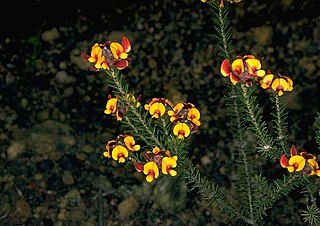
Thomasia sarotes is a species of flowering plant in the family Malvaceae. It is an upright, spreading shrub with purple, pink to mauve or white flowers and is endemic to the south-west of Western Australia.
Dillwynia divaricata is a species of flowering plant in the family Fabaceae and is endemic to the south-west of Western Australia. It is an erect, spindly shrub with cylindrical, grooved leaves and yellow flowers with brownish markings.

Dillwynia uncinata, commonly known as silky parrot-pea, is a species of flowering plant in the family Fabaceae and is endemic to southern Australia. It is an erect, spreading shrub with cylindrical leaves and yellow flowers with a red centre.
Pultenaea adunca is a species of flowering plant in the family Fabaceae and is endemic to the south of Western Australia. It is an erect, spindly shrub with hairy, needle-shaped leaves and yellow and red flowers.
Hibbertia helianthemoides is a species of flowering plant in the family Dilleniaceae and is endemic to a small area in the south-west of Western Australia. It is a prostrate to low-lying, spreading to erect, hairy shrub with hairy foliage, linear leaves and yellow flowers with thirteen stamens.
Pultenaea brachyphylla is a species of flowering plant in the family Fabaceae and is endemic to the south of Western Australia. It is an erect, spindly shrub with cylindrical, grooved leaves and yellow, orange and brown flowers.

Hibbertia mucronata is a species of flowering plant in the family Dilleniaceae and is endemic to the south of Western Australia. It is an erect shrub with hairy branches, crowded, thick, tapering linear leaves ending in a sharp point, and golden yellow flowers with five stamens fused at their bases, all on one side of two densely hairy carpels.
Pultenaea spinulosa is a species of flowering plant in the family Fabaceae and is endemic to the south of Western Australia. It is a shrub with flat, hairy leaves, and uniformly yellow flowers.

Pultenaea verruculosa is a species of flowering plant in the family Fabaceae and is endemic to the south-west of Western Australia. It is an erect shrub with flat, hairy leaves, and yellow-orange and red, pea-like flowers.

Daviesia lancifolia is a species of flowering plant in the family Fabaceae and is endemic to the south-west of Western Australia. It is a prostrate to erect, spreading shrub with egg-shaped, more or less round or linear phyllodes and yellow to orange and red flowers.
Daviesia pachyloma is a species of flowering plant in the family Fabaceae and is endemic to the south-west of Western Australia. It is an erect, bushy or spreading shrub with zigzagging branches, sharply-pointed, narrowly elliptic to linear phyllodes, and yellow and red flowers.

Lasiopetalum rosmarinifolium is a species of flowering plant in the family Malvaceae and is endemic to the south-west of Western Australia. It is an erect or spreading shrub with hairy stems and leaves, linear leaves and white flowers.
Olearia imbricata, commonly known as imbricate daisy bush, is a species of flowering plant in the family Asteraceae and is endemic to the south-west of Western Australia. It is a shrub with small, overlapping linear leaves and bluish-purple or white, daisy-like inflorescences.

Daviesia striata is a species of flowering plant in the family Fabaceae and is endemic to the south of Western Australia. It is a rigid, glabrous shrub with erect branchlets, crowded, vertically compressed, sharply-pointed phyllodes, and yellow and red flowers.

Mirbelia subcordata is a species of flowering plant in the family Fabaceae and is endemic to the south-west of Western Australia. It is an erect, spreading shrub with egg-shaped to lance-shaped leaves and yellow or orange and red flowers.

Spyridium microcephalum is a species of flowering plant in the family Rhamnaceae and is endemic to the south-west of Western Australia. It is a spreading or erect shrub with linear leaves and heads of woolly-hairy flowers.
Spyridium villosum is a species of flowering plant in the family Rhamnaceae and is endemic to the south-west of Western Australia. It is a small shrub with shaggy-hairy branchlets, linear to oblong leaves and dense heads of hairy flowers with broad brown bracts at the base.
Marianthus granulatus is a species of flowering plant in the family Pittosporaceae and is endemic to a restricted part of the southwest of Western Australia. It is a twining shrub or climber with often clustered, egg-shaped to heart-shaped leaves and pale blue flowers with darker blue spots and yellow streaks, arranged in groups of three to five.
Marianthus microphyllus is a species of flowering plant in the family Pittosporaceae and is endemic to the south of Western Australia. It is a small, erect, spreading shrub with clustered, funnel-shaped, stem-clasping leaves and deep blue to almost purple flowers that darken as they age, arranged singly in leaf axils.

Chorizema humile is a species of flowering plant in the family Fabaceae and is endemic to the southwest of Western Australia. It is a sprawling, prostrate or low-lying shrub with egg-shaped or wedge-shaped leaves and yellow and reddish-brown flowers.










